Your Texas 2036 Guide: Texas by the Numbers
This is a preview of our Texas 2036 newsletter with our guide to Texas by the numbers. To receive this weekly look at our work, sign up here.
Texas by the Numbers: Who We Are Now

Think you know Texas? Let’s test it. We’re unpacking the people, places and trends shaping the state: what’s growing, what’s slowing and what’s next.
Want Texan bragging rights at your next dinner table debate? Here’s the latest on who Texans are, where we live and what’s changing fastest.
Texans are young, growing and diverse
Texas Population by Generation, 2023
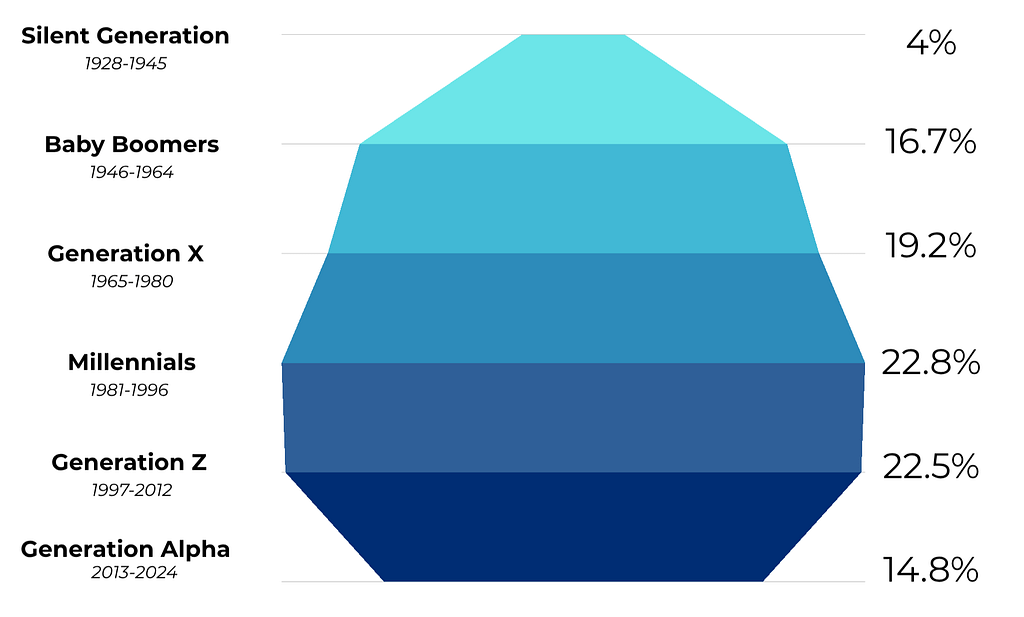 Source: Texas Demographic Center
Source: Texas Demographic Center
- Texas is home to over 31 million people today, and up to 5 million more are expected by 2036.
- Millennials and Gen Z make up nearly half of the population, fueling a young, dynamic workforce.
- With a median age of 35, Texas is the second-youngest state after Utah.
- One in four Texans is under 18, underscoring the state’s growing pipeline of talent.
- Meanwhile, Texans aged 65 and up are predicted to be the fastest-growing age group through 2050.
- Children still outnumber seniors statewide, but 76 counties now have more seniors than kids.
🗳️ The average age of Texas voters who participated in the 2024 November general election was 50.6 years.
(Source: Baselice & Associates LLC)
 As of 2025, Hispanics, especially Hispanic women, are the largest demographic group in Texas.
As of 2025, Hispanics, especially Hispanic women, are the largest demographic group in Texas.
By 2036, women will make up the largest demographic group in Texas, with Hispanic women representing the largest ethnic subgroup.
(Source: Texas Demographic Center)
Texans are concentrated in the Triangle
Estimated Numeric Change, Texas Counties, 2023-24
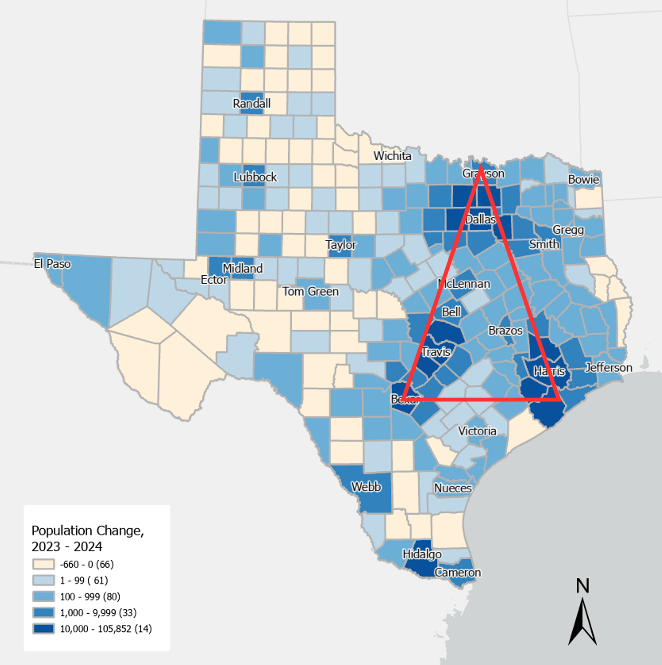 Source: U.S. Census Bureau, Vintage 2024 Population Estimates
Source: U.S. Census Bureau, Vintage 2024 Population Estimates
- Seven-out-of-ten Texans now live within the “Texas Triangle,” connecting Houston, Dallas-Fort Worth, Austin and San Antonio.
- Rural vs. Urban: More than 24 million Texans live in an urban area; whereas, 4.7 million live in rural areas. Texas has the largest rural population of any state.
- Fast-forward to 2060, outside of the Texas Triangle, Hidalgo and El Paso counties will be among the most populous places, with nearly a million or more residents in each county.
 Did you know? Texas is multilingual at its core. Roughly one in three Texans speaks a language other than English at home, most often Spanish.
Did you know? Texas is multilingual at its core. Roughly one in three Texans speaks a language other than English at home, most often Spanish.
Houston is one of the most ethnically and culturally diverse cities in the U.S. The top five languages spoken in Houston are: English, Spanish, Vietnamese, Chinese and Arabic.
Migration keeps fueling our growth
Texas State-to-State Net Domestic Migration, 2023
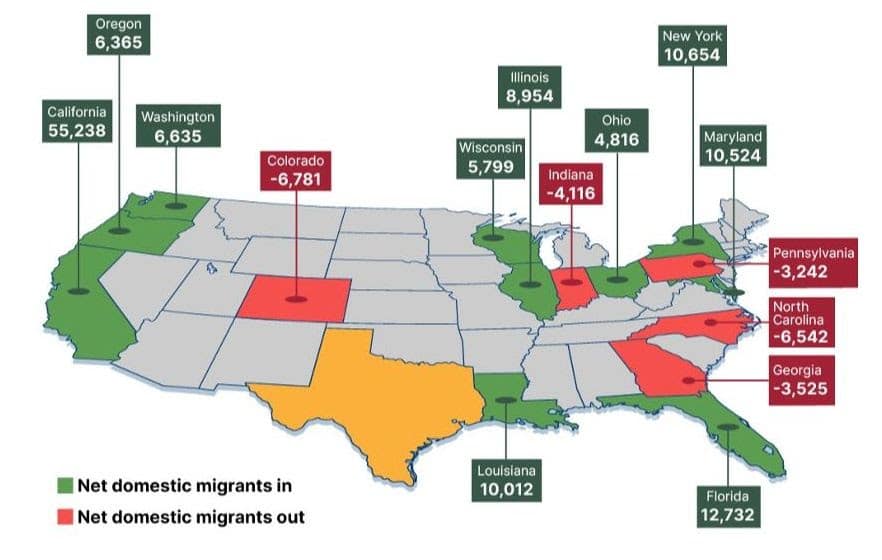 Source: Texas Demographic Center and U.S. Census Bureau, 2023 State-to-State Migration Flows Statistics
Source: Texas Demographic Center and U.S. Census Bureau, 2023 State-to-State Migration Flows Statistics
Texas is a hotbed for growth, gaining more than 1,500 new residents a day.
Where are they coming from?
People are moving to Texas from all over the country.
- The top net states to Texas in 2023 were California, Florida, New York, Maryland, Louisiana and Illinois.
- In total, about 612,000 people moved to Texas from other states in 2023, creating a net gain of about 133,000 through domestic migration.
How many Texans are leaving?
Even as the state grows, some residents are heading out.
- In 2023, more than 478,000 people left the state for other parts of the United States, according to the U.S. Census Bureau.
- But in 2023, the top net receiving states were Colorado, North Carolina, Indiana, Georgia and Pennsylvania, according to the Texas Demographic Center.
Fewer Texas babies projected to be born
Total Fertility Rate Trends of the U.S. and Texas, 2000-22
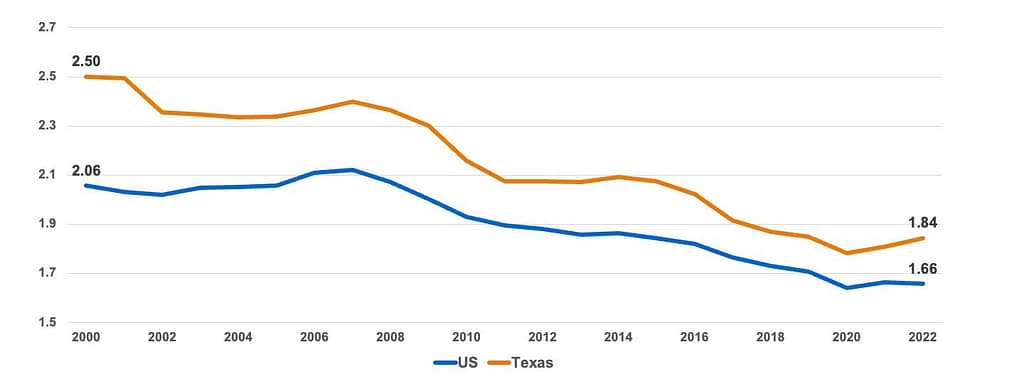 Source: National Vital Statistics Reports, Centers for Disease Control and Prevention
Source: National Vital Statistics Reports, Centers for Disease Control and Prevention
Note: The total fertility rate is a demographic indicator that estimates the average number of children a woman will have during her childbearing years
For years, Texas has grown through three main forces: more births, new arrivals from across the U.S. and people moving here from around the world. Now, those patterns are starting to shift.
From Baby Boom to Baby Pause
Every 90 seconds, a baby is born in Texas — about 1,000 babies a day. But that number is beginning to fall as birth rates decline.
- More Texans are waiting longer to start families, with fewer births among younger women and more among those in their thirties and forties.
- Nationwide, fertility rates are dropping, yet Texas remains above average at 1.84 compared to 1.66 nationally, with a small uptick after the pandemic.
International migration to Texas is slowing
Migration Trends Reshape Texas Population Growth Outlook
Roughly one-third of Texas’ near-term population growth is expected to come from net international migration. As natural increase (births minus deaths) declines, migration will become increasingly vital to shaping the state’s demographics.
However, international migration has dropped sharply since January after several years of high levels, according to Helen You, associate director and senior demographer at the Texas Demographic Center.
“We will closely monitor the trend and evaluate its impact on future population growth,” she said.
Why it matters: This shift underscores the importance for policymakers and planners to track migration trends and their long-term effects on Texas’ workforce, infrastructure and communities.
Projected Texas Population Shifts 2024-2054
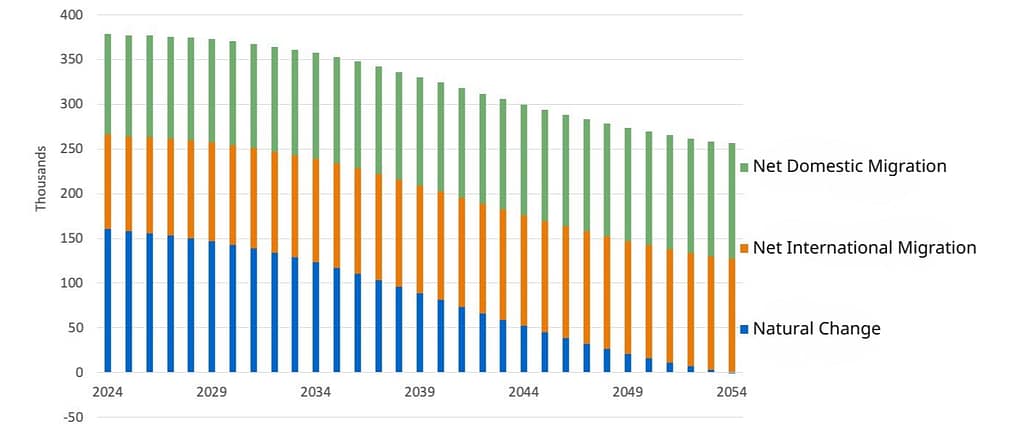 Source: Texas Demographic Center, Vintage 2024 Population Projections
Source: Texas Demographic Center, Vintage 2024 Population Projections
Under a mid-migration scenario, the projections are assuming that the U.S. and Texas migration patterns remain the same to what happened in the last two decades. This is what the TDC recommends for most purposes.
Texas 2036: Turning insight into impact

Behind these numbers are the state’s policy decisions that will shape Texas’ future: where to spend taxpayer dollars wisely, how to prepare for both a young and aging population and how to expand opportunity for every Texan.
At Texas 2036, we provide the trusted data to guide those choices.

